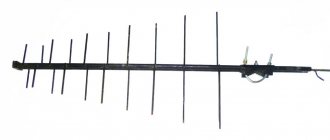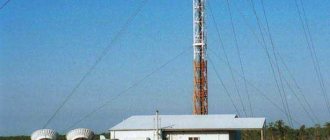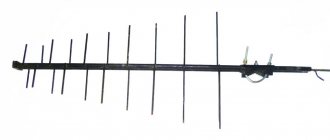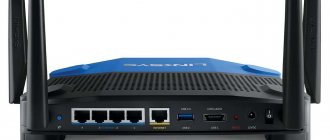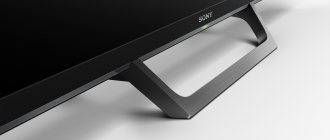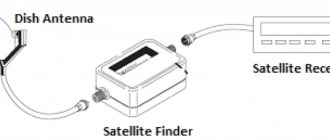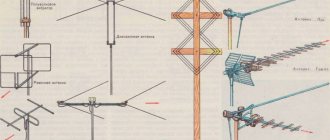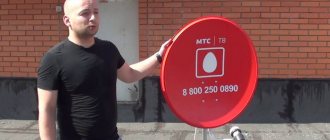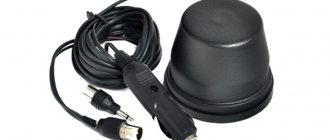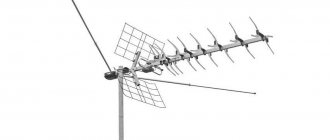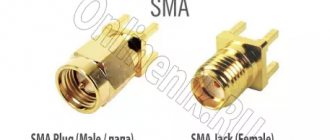— What range is this antenna for?
- I don’t know, check. - WHAT?!?! How can you determine what kind of antenna you have in your hands if there is no marking on it? How to understand which antenna is better or worse? This problem has plagued me for a long time. The article describes in simple language the technique for measuring antenna characteristics and the method for determining the frequency range of the antenna.
To experienced radio engineers, this information may seem trivial, and the measurement technique may not be accurate enough. The article is intended for those who do not understand anything at all about radio electronics, like me.
TL;DR
We will measure the SWR of antennas at various frequencies using the OSA 103 Mini device and a directional coupler, plotting the dependence of SWR on frequency.
Theory
When a transmitter sends a signal to an antenna, some of the energy is radiated into the air, and some is reflected and returned back.
The relationship between radiated and reflected energy is characterized by the standing wave ratio (SWR or SWR). The lower the SWR, the more of the transmitter's energy is emitted as radio waves. At SWR = 1 there is no reflection (all energy is radiated). The SWR of a real antenna is always greater than 1. If you send a signal of different frequencies to the antenna and simultaneously measure the SWR, you can find at what frequency the reflection will be minimal. This will be the operating range of the antenna. You can also compare different antennas for the same band and find which one is better.
Part of the transmitter signal is reflected from the antenna
An antenna designed for a certain frequency, in theory, should have the lowest SWR at its operating frequencies. This means that it is enough to radiate into the antenna at different frequencies and find at which frequency the reflection is the smallest, that is, the maximum amount of energy has flown away in the form of radio waves.
By being able to generate a signal at different frequencies and measure the reflection, we can create a graph with the frequency on the X axis and the reflectivity of the signal on the Y axis. As a result, where there is a dip in the graph (that is, the least reflection of the signal), there will be an operating range of the antenna.
Imaginary graph of reflection versus frequency. Over the entire range, the reflection is 100%, except for the operating frequency of the antenna.
Device Osa103 Mini
For measurements we will use OSA103 Mini. This is a universal measuring device that combines an oscilloscope, a signal generator, a spectrum analyzer, an amplitude-frequency response/phase response meter, a vector antenna analyzer, an LC meter, and even an SDR transceiver. The operating range of the OSA103 Mini is limited to 100 MHz, the OSA-6G module expands the frequency range in IAFC mode to 6 GHz. The native program with all functions weighs 3 MB, runs on Windows and via wine on Linux.
Osa103 Mini - a universal measuring device for radio amateurs and engineers
Directional coupler
A directional coupler is a device that diverts a small portion of an RF signal traveling in a specific direction.
In our case, it must branch off part of the reflected signal (going from the antenna back to the generator) to measure it. A visual explanation of the operation of a directional coupler: youtube.com/watch?v=iBK9ZIx9YaY Main characteristics of a directional coupler:
- Operating frequencies
- the range of frequencies at which the main indicators do not exceed normal limits. My coupler is designed for frequencies from 1 to 1000 MHz - Coupling
- how much of the signal (in decibels) will be coupled when the wave is directed from IN to OUT - Directivity
- how much less signal will be rejected when the signal moves in the opposite direction from OUT to IN
At first glance this looks quite confusing. For clarity, let's imagine the coupler as a water pipe, with a small tap inside. The drainage is made in such a way that when water moves in the forward direction (from IN to OUT), a significant part of the water is removed. The amount of water that is discharged in this direction is determined by the Coupling parameter in the coupler datasheet.
When water moves in the opposite direction, significantly less water is removed. It should be taken as a side effect. The amount of water that is discharged during this movement is determined by the Directivity parameter in the datasheet. The smaller this parameter is (the larger the dB value), the better for our task.
Schematic diagram
Since we want to measure the signal level reflected from the antenna, we connect it to the IN of the coupler, and the generator to OUT. Thus, part of the signal reflected from the antenna will reach the receiver for measurement.
Connection diagram for the tap. The reflected signal is sent to the receiver
Measuring setup
Let's assemble a setup for measuring SWR in accordance with the circuit diagram.
At the output of the device generator, we will additionally install an attenuator with an attenuation of 15 dB. This will improve the matching of the coupler with the generator output and increase the measurement accuracy. The attenuator can be taken with an attenuation of 5..15 dB. The amount of attenuation will be automatically taken into account during subsequent calibration. An attenuator attenuates the signal by a fixed number of decibels. The main characteristic of an attenuator is the attenuation coefficient of the signal and the operating frequency range. At frequencies outside the operating range, the attenuator's performance may change unpredictably. This is what the final installation looks like. You must also remember to supply an intermediate frequency (IF) signal from the OSA-6G module to the main board of the device. To do this, connect the IF OUTPUT port on the main board to the INPUT on the OSA-6G module.
To reduce the level of interference from the laptop's switching power supply, I carry out all measurements when the laptop is powered by battery.
Preparation of materials
So, the theory is over, it's time to get down to practice. And for this you will need to take everything you need to create your own antenna. First of all, these are the wire or rods that will make up the main receiving part of your antenna. Secondly, you will need a base for your antenna. It is advisable that it has several holes that you can use to attach pins. If these holes are missing, you will have to either drill holes or solder directly to straight metal, which is not very convenient and will not allow you to correctly calculate the length in advance. Therefore, use a base with pre-drilled holes. Naturally, you will need other things, such as a soldering iron, but everyone knows about this, so there is no point in listing all such items.
Calibration
Before starting measurements, you need to make sure that all components of the device are in good working order and the quality of the cables; to do this, we connect the generator and receiver directly with a cable, turn on the generator and measure the frequency response. We get an almost flat graph at 0dB. This means that over the entire frequency range, all the radiated power of the generator reached the receiver.
Connecting the generator directly to the receiver
Let's add an attenuator to the circuit. An almost even signal attenuation of 15dB is visible throughout the entire range.
Connecting the generator through a 15dB attenuator to the receiver
Let's connect the generator to the OUT connector of the coupler, and the receiver to the CPL connector of the coupler. Since there is no load connected to the IN port, all the generated signal must be reflected, and part of it must be branched to the receiver. According to the datasheet for our coupler (ZEDC-15-2B), the Coupling parameter is ~15db, which means we should see a horizontal line at a level of about -30 dB (coupling + attenuator attenuation). But since the operating range of the coupler is limited to 1 GHz, all measurements above this frequency can be considered meaningless. This is clearly visible in the graph; after 1 GHz the readings are chaotic and meaningless. Therefore, we will carry out all further measurements in the operating range of the coupler.
Connecting a tap without load. The limit of the operating range of the coupler is visible.
Since measurement data above 1 GHz, in our case, does not make sense, we will limit the maximum frequency of the generator to the operating values of the coupler. When measuring, we get a straight line.
Limiting the generator range to the operating range of the coupler
In order to visually measure the SWR of antennas, we need to perform a calibration to take the current parameters of the circuit (100% reflection) as a reference point, that is, zero dB. For this purpose, the OSA103 Mini program has a built-in calibration function. Calibration is performed without a connected antenna (load), calibration data is written to a file and is subsequently automatically taken into account when constructing graphs.
Frequency response calibration function in the OSA103 Mini program
Applying the calibration results and running measurements without load, we get a flat graph at 0dB.
Graph after calibration
We measure antennas
Now you can start measuring the antennas. Thanks to calibration, we will see and measure the reduction in reflection after connecting the antenna.
Kharchenko for 3G and 4G communications
Mobile Internet modems have a small built-in antenna, which does not have much power. Internet signal reception can be enhanced by connecting an external antenna. And a biquadrat can be made to improve 3G or 4G reception.
This is done in the same way, only in different sizes. Therefore, you need to find out the broadcast frequency of mobile operators. The meanings for each operator are slightly different. But the general limits are the same for everyone.
Extreme frequencies – 1.9-2.1 GHz. If we substitute the values into the formula, the wavelength will be 14-16 cm. And the side of the antenna is 3.5 and 4 cm.
The reflective element is made in the same way, but moves away from the antenna by 21 mm. The mobile antenna is connected to the modem using a regular headphone plug – mini Jack 3.5 mm.
Not all modems have a connector for an additional antenna. In this case, it is necessary to disassemble the modem and connect Anna Kharchenko.
Telescopic antenna
Let's try to calculate how far the telescopic antenna needs to be extended for the 433MHz range. The formula for calculating the wavelength is: λ = C/f, where C is the speed of light, f is the frequency. 299.792.458 / 443.000.000 = 0.69719176279 Full wavelength
- 69.24 cm
Half wavelength
- 34.62 cm
Quarter wavelength
- 17.31 cm
The antenna calculated in this way turned out to be absolutely useless. At a frequency of 433MHz the SWR value is 11.
By experimentally extending the antenna, I managed to achieve a minimum SWR of 2.8 with an antenna length of about 50 cm. It turned out that the thickness of the sections is of great importance. That is, when extending only the thin outer sections, the result was better than when extending only the thick sections to the same length. I don’t know how much you should rely on these calculations with the length of a telescopic antenna in the future, because in practice they don’t work. Maybe it works differently with other antennas or frequencies, I don’t know.
Execution of work
First of all, you need to prepare material for further work. To do this, you need to clean all the pins, tin them and treat them with flux. After this, you need to cut the pins to the required length, but do not forget to leave a little length so that you can then adjust the finished result. Then you need to start soldering - each of the pins needs to be soldered on the back of the antenna, and then take another one that will be attached to the antenna. Its length no longer plays a role, since it will serve as a holder and will not be responsible for receiving the signal. It also needs to be soldered, after which you can already admire the result of your work.
A piece of wire at 433MHz
Often in various devices, such as radio switches, you can see a piece of straight wire as an antenna. I cut a piece of wire equal to a quarter wavelength of 433 MHz (17.3 cm) and tinned the end so that it fits snugly into the SMA Female connector.
The result was strange: such a wire works well at 360 MHz but is useless at 433 MHz.
I started cutting the wire off the end piece by piece and looking at the readings. The dip in the graph began to slowly move to the right, towards 433 MHz. As a result, over a wire length of about 15.5 cm, I managed to get the smallest SWR value of 1.8 at a frequency of 438 MHz. Further shortening of the cable led to an increase in the SWR.
What is needed for production
To make an antenna with your own hands you will need:
- copper wire with a thickness of 1.5 to 5 mm;
- antenna cable with a resistance of 75 Ohms (standard value for TV signal transmission), the length of the wire depends on the location of the antenna (the further away, the longer the length);
- measuring instrument (ruler, centimeter or tape measure);
- pliers or a vice to bend the wire evenly;
- a soldering iron to connect the inner ends of the biquadrate to each other and to the television cable;
- F-type connector for installing an adapter on the second end of the cable to connect to a TV or set-top box;
- insulating material to protect connections from external influences if installation is done outside the building (insulating tape, epoxy resin, varnish, hot melt adhesive).
Depending on the installation location, material may be required to construct the fastening. For example, if Kharchenko’s structure is placed on the roof of a private house, then a mast can be made. In this case, you can use plastic pipes or wooden blocks.
